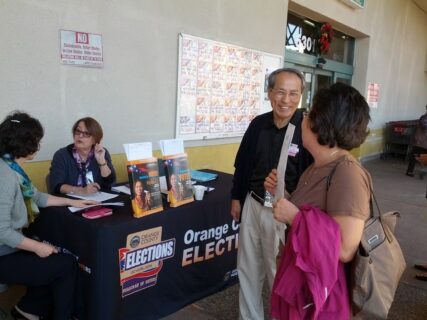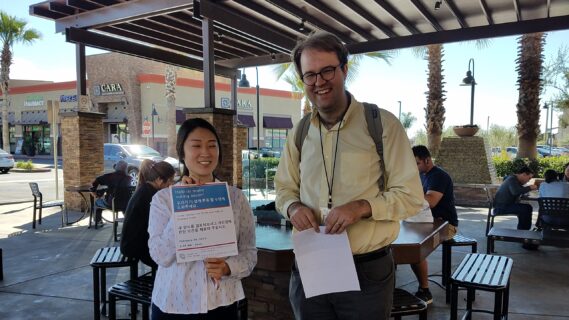Libraries, parks and community centers: Go where the people are for usability testing
At CCD, we think the best way to find out if a form, brochure, or letter works is simple: Ask the people who will use it. It’s called usability testing and it’s a way to check that all of your materials work well, before you launch them.
But how will you find a group of people for your testing that matches the range and diversity of your voters? We use an approach called “intercept testing.” Instead of scheduling people in advance and asking them to come to you, you go to them.
You find a public space – the library, a community center, a market – and just go up to people and ask them if they will spend a few minutes talking to you. This approach to usability testing allows you to hear from a diverse set of voters — and people who are not yet voters.
All you really need is a clipboard, some questions, and a few people who are willing to talk to a stranger who asks for their input.
So how do you get started? We’ve got a few tips that we hope will inspire your election office to try intercepts for your next intercept test.

Choose a location where there are enough people with a few minutes to spare
When brainstorming locations, think of places with a good amount of foot traffic that also aren’t too crowded and have a high chance of people with a few minutes to spare. Look for somewhere you can use an existing place to sit, such as a bench, seats in a waiting area, existing tables, or a table you bring yourself.
We’ve had success with running intercepts outside of libraries, community centers, space and public parks, local college campuses, county office service center lobbies, shopping centers, farmer’s markets, and transit hubs at the DMV. Be sure to ask for permission in advance and that there is a place for you to set up where you won’t interfere with the usual function of the location.
You’ll want to be looking for locations in neighborhoods with different kinds of voters – by age, demographics, or districts with lower turnout. Another tip is to try multiple locations to increase the diversity of your participants.
And, be ready to adapt your plan as you go. It might rain, or there can be an unexpected event filling the space, fewer people than you hoped for, or other distractions that make people uninterested. For example, in a recent intercept test we conducted, we decided to try a public library in Woodside, Queens after the nearby public park had few people.
Come prepared: what to bring for your testing day
When you’re doing intercept testing, you will probably want to use paper and a clipboard, or a tablet to read your questions and take notes. A laptop is too cumbersome to use while standing.
- Clipboard and pens
- Materials you will show testers
- A token of appreciation (some election swag, cash, or a gift card), if you choose to offer one
- A backpack (a hands-free place to hold your supplies)
- Water (really!)
Remember to plan ways to make people feel comfortable when you approach them. A badge or name card can help people identify you quickly. If you are setting up a table, a sign or table running with your office name shows that you are from the elections office. Clear identification will help people feel comfortable when you are approaching them.

During the “intercept” make it easy for people to say yes
Your attire represents your election office or organization. A badge or name card that identifies your name and where you work is important so that people can immediately know who you are and feel comfortable when you are approaching them.
When approaching someone, be mindful of what they are doing, whether they are talking on the phone, using headphones or busy in some way.
Be prepared with a strong and clear opening statement that tells people what you’re asking and what they’ll receive by volunteering. Keep it short and simple.
Let people know how much time the testing will take as people typically want to know what they are signing up for before they agree. The testing should not last longer than 15-20 minutes – if it does, the interview is better suited for a scheduled session.
Here’s an example of some opening lines you can use to approach people,
- “We’re offering $20 to share your thoughts on our voter guide. It will just take a few minutes.”
- “I’d like to borrow 15 minutes of your time to help make it easier to register to vote. We’re offering $10 for your time.”
- “While you are waiting, can I ask you a few questions about voting?”
- “We’d like your help making it easier to learn about voting. Do you have 10 minutes to share your thoughts?”
Phrases like, “We’re conducting usability testing,” are a little too obscure.
Sometimes you can enlist people at the site to help you find participants. At a One-Stop Jobs Center, the front desk let people coming in know that we were looking for people to talk about voting and we got a steady stream of participants.
When taking notes in the wild, a note-taking form is your friend
Remember that clipboard you packed? It can help you take notes and keep your papers organized, whether you are standing up or using a table.
One tip for taking notes more easily is to prepare forms that have both your questions and room to write down what you learn. Little checkboxes can also be helpful for quick answers like whether the participant is registered to vote or if they vote in person or by mail.
You can also work in pairs, with one person talking to the participant and the other taking notes. Working with a partner is also a good safety tip.
Intercepts are an effective way to get feedback quickly
While it might seem a little risky to count on getting good feedback from random people at a random location, intercepts can actually help you find a more representative group of usability testing participants.
You can find people who might never volunteer to meet you at a particular place and time, but who are happy to spend a few minutes talking to you.
Every time we go out “where the people are” we rediscover how eager people are to participate in the democratic process.
Further resources
Talking to strangers on the street, by Dana Chisnell in UX Magazine
Slideshow: Go where the people are – intercepts in usability testing
More about usability testing
Vol. 03 Testing Ballots for Usability, Center for Civic Design Field Guide
Usability Testing Kit on ElectionTools.org
Design, test, repeat: designing a new ballot record form
How to adapt usability tests to fit the needs of your project
What can you learn from usability testing in the civic space (a more theoretical article but has some great examples of research questions
Center for Civic Design’s Election Design Course from the University of Minnesota Certificate in Election Administration. The course includes usability testing as a core skill and uses it throughout the course.
This was originally published in our Civic Designing newsletter. Subscribe on Mailchimp to get election design tips delivered to your mailbox.

